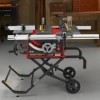Craftsman 21829 Operation Manual - Page 23
Of Kickback
 |
View all Craftsman 21829 manuals
Add to My Manuals
Save this manual to your list of manuals |
Page 23 highlights
CAUSES OF KICKBACK Kickback can occur when the blade stalls or binds, kicking the workpieca back toward you with great force and speed. If your handsare near the saw blade, they may be jerked loosefrom the workpiece and may contact the blade. Kickback can cause seriousinjury.Use precautions to avoidthe risks. Kickback can be caused by any action that pinches the blade in the wood such as: • Making a cut with incorrect blade depth • Sawlng into knots or nailsin the workpiece • Twistingthe wood while makinga out • Failing to supportwork • Forcing a cut • Cutting warped orwet lumber • Us{ng the wrong blade for the type of cut • Not following oorrect operating procedures • Misusing the saw • Failing to use the an_-kick.baokpawls • Cutting with a dull, gummed-up, or h'npmperiy set b_ad_ AVOIDING KICKBACK • Always use the correct blade depth setting. The top of the blade teeth shouldclear the workpiece by 1/8 in. to 114in. • Inspect the work for knots or nailsbefore beginninga cut KnocY,out any loose knots w_tha hamme_'N. ever saw into a loose knot or na|(. • Always use the rip fence when rip cutting and the miter gauge when cross cutting.This helps preventtwisting the wood in the cut. • Always use cLsans, harp, and properly-set blades, Never make outs with dull blades. • TOavoid pinchingthe blade, supportthe work properly before beginning a cut, • When making a cut. usesteady, even pressure. Never force outs. • Do not cut wet or warped lumber. • Always herdyour workplece fLrmtywith both hands or with push sticks. Keep your body in a balanoed position to be ready to resist kickbackshould it occur. Never stand direc_y in line with the blade. • Use the right type of blade for the cut being made. CUTTING AIDS See Figure 24. Push sticksare devices used for safelypushing a workpLscethroughthe blade. They can be made _'orn scrap wood in various sizes and shapes to be used in a specific project.The stick must be narrowerthan the workpieoe,with s g0° notchin one end and shapingfor a grip on the other end. A push block has a handle fastened by recessed screws from the underside. Use it on non-throughcuts. CAUTION: Be sure the screws in a push blockare recessedto avoid damagingthe saw or workpiece. PUStlSTICKS Rg. 24 23















